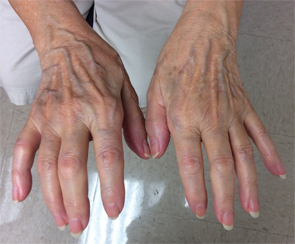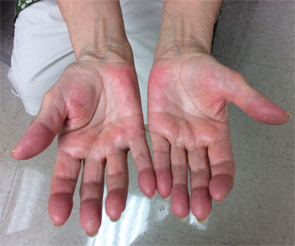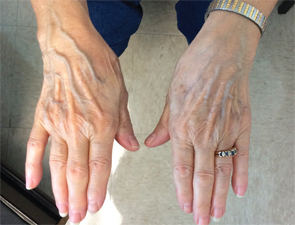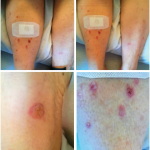
Image Credit: Molodec/shutterstock.com
Case report: A 78-year-old Caucasian female presented to our outpatient rheumatology clinic with pain in her bilateral shoulders, hands and knees that began suddenly one month earlier. She admitted to stiffness in her hands lasting several hours, and expressed an inability to extend her fingers. She denied fever, rashes, jaw claudication, headache or visual changes. She also denied having night sweats, unintentional weight loss, shortness of breath or abdominal pain.
Her past medical history was unremarkable, with no prior history of malignancy. She did not take any medication. Her vital signs were stable, and she was afebrile. She had normal breath sounds and a regular heart rate and rhythm. She exhibited no abdominal tenderness.
The physical exam was notable for tenderness of both shoulders, with limited range of motion. She had bilateral hand swelling with tenderness to palpation of the palms and proximal and distal interphalangeal joints. She had multiple flexion contractures, with erythema noted extending over the palms and digits (see Figures 1A & 1B). She had no sclerodactyly, nail pitting, Raynaud’s phenomenon or telangiectasias, and no proximal muscle weakness was evident. She had very small effusions in both knees, but the volume was insufficient to aspirate.
Pertinent lab results included a negative rheumatoid factor (RF), negative cyclic citrullinated peptide (CCP) antibodies and a negative result for antinuclear antibodies (ANA). A myositis antibody panel was also negative. Serum creatine kinase level was 36 u/L (normal range 24–173). The erythrocyte sedimentation rate (ESR) was 23 mm/hr (normal range 0–40). The C-reactive protein (CRP) was strikingly elevated at 67.1 mg/L (normal range 0.0–4.9). The complete blood count, electrolytes and hepatic function panel were normal. A chest X-ray was normal, and X-rays of both hands showed mild osteoarthritic changes with joint space narrowing to the proximal interphalangeal and distal interphalangeal (DIP) joints on digits 2–5 bilaterally. Bilateral knee X-rays were normal.


Figure 1A (left) & Figure 1B: These images show the patient’s hands on initial presentation to the rheumatologist, with visible flexion contractures of all digits and swelling, erythema and pain on palpation.

Dr. Kesselman
A diagnosis of palmar fasciitis and polyarthritis syndrome (PFPAS) was rendered. The patient was started on 20 mg prednisone daily with a slow taper planned, and she was advised to follow up with her primary care physician for cancer screening. She had a DEXA scan performed, which showed a normal bone density, with a lumbar spine T score of –0.7, and a hip T score of –0.9. She refused treatment for prevention of glucocorticoid-induced osteoporosis, but agreed to take daily calcium and Vitamin D.
On her three-month follow-up visit, she had successfully tapered prednisone to 7.5 mg daily. The pain and swelling in her hands had vanished, and although the flexion contractures had vastly improved, they were still present on examination. She had increased range of motion in her fingers and full grip strength (see Figures 2A & 2B, opposite). The swelling in her knees had resolved. The CRP had completely normalized to <1 mg/L.
At her nine-month follow-up visit, she continued to do well, with no hand pain or swelling. The contractures continued to show improvement, with no pain noted on palpation of her hand tendons. She is currently taking 2.5 mg of prednisone every other day and feels well. Her age-appropriate cancer screening has been negative.
Discussion
Palmar fasciitis and polyarthritis syndrome is a rare paraneoplastic condition characterized by rapidly progressive flexion contractures of the hands, inflammatory fasciitis, generalized hand arthritis, fibrosis and a generalized inflammatory arthritis of the joints.1 It is a non-erosive arthropathy, and laboratory tests for inflammatory markers and autoimmune antibodies are generally normal.
The etiology is thought to be due to fibroblast proliferation and connective tissue growth factors (CTGFs). The exact incidence is unknown, but since it was first described in 1982 in association with ovarian carcinoma, more than 40 cases have been reported, with the majority occurring in elderly females.2 The condition has also been associated with colon, pancreas, lung and hemolymphatic malignancies.
The rheumatic symptoms usually precede the occurrence of cancer, but can also occur simultaneously with or follow the malignancy. A handful of cases with no association with malignancy has also been described. The condition was first reported in 1982 by Medsger et al in association with ovarian carcinoma.2


Figure 2A (left) & Figure 2B: These images show the patient’s hands following three months’ treatment with prednisone. The patient has visible improvement of the swelling and contractures and no pain on palpation.
Epidemiology
In an analysis of 41 PFPAS cases reported between 1982 and 2005, close to one-third of the cases were associated with ovarian cancer.1 Other associated malignancies include prostate, lung, breast and hematological malignancies. The rheumatic symptoms preceded the tumor detection anywhere from one to 23 months.1
The etiology of PFPAS remains unknown. Possible explanations include the activation of certain profibrotic factors from neoplastic cells or an antigen-antibody autoimmune phenomenon within malignant cells. Indeed, Medsger and colleagues had originally suggested that a fibroblast proliferative factor may be secreted by the tumor.2
A pathological fibrotic factor, such as CTGF, is proposed to play a role in this process. Yogarajah et al described elevated levels of CTGF in a patient with PFPAS in association with ovarian malignancy.3
Whether CTGF has any diagnostic implication is unknown at this time, as it is not a routinely ordered test. Skin biopsy from patients with PFPAS may reveal dense connective tissue, inflammatory infiltrates and immunoglobulin deposition. However, these findings are not exclusive to PFPAS. In addition, plain radiographs and magnetic resonance imaging of the hands provide limited diagnostic utility beyond what the clinical picture affords.4
The differential diagnosis of PFPAS includes rheumatoid arthritis, scleroderma, reflex sympathetic dystrophy, Dupuytren’s contracture, diabetic cheiroarthropathy and eosinophilic fasciitis.4
Our patient lacked Raynaud’s phenomenon and had a negative ANA, which is inconsistent with scleroderma. Negative RF and CCP antibodies, coupled with DIP joint involvement, made RA unlikely. RSD is marked by symptoms of vasomotor disturbances and does not present acutely. RSD is usually seen in one extremity and is not associated with diffuse arthritis. It also typically follows an acute traumatic injury, which did not occur in this patient.
Dupuytren’s contracture is a relatively common condition and presents insidiously with nodular thickening and contraction of the palmar fascia.1 Although its manifestation can resemble PFPAS, it usually affects the ulnar side of both hands, and male predominance is common. Joint arthritis is also not a prominent feature of this condition.
Persons with longstanding and poorly controlled insulin-dependent diabetes mellitus may develop diabetic cheiroarthropathy, characterized by thickening of the digits and palmar flexion contractures producing the classic prayer sign.4 Our patient was not diabetic.
Eosinophilic fasciitis presents with myalgia and forearm thickening, which leads to palmar and finger flexion contractures.4 Peripheral eosinophilia is characteristic of this condition, but was absent in our patient.
Treatment
Anti-inflammatory drugs or corticosteroids have limited benefit in treating PFPAS-associated malignancy. Such patients do not respond to steroid treatment, but rather improve upon treating the underlying malignancy, although residual contractures may remain.3,5 PFPAS patients with no concurrent neoplasm seem to improve with steroid treatment.1

Dr. Raj
Our patient responded well to moderate doses of prednisone and was able to taper down quite steadily. Although most case reports have described the association of PFPAS with different malignancies, a few reported cases of PFPAS had no detectable neoplasm.
Seaman et al reported seven patients who developed palmar fasciitis within four months of starting the anti-tuberculosis drug ethionamide.6 The palmar fasciitis resolved when the treatment was discontinued. Another case described a 75-year-old woman who developed an idiopathic case of PFPAS. However, the possibility of a future malignancy could not be discounted because of a follow-up of just 12 months.1
Sung et al reported a case of idiopathic PFPAS in a 31-year-old Korean woman who was successfully treated with corticosteroids.1 Her PFPAS was not found to be associated with malignancy during the 24-month follow-up period from the onset of her first symptoms.
Conclusion
Our patient has continued to remain healthy, and she has shown no evidence of malignancy over the relatively short time period of 10 months since her symptom onset. Perhaps a positive indication that she may be neoplasm free is her rapid improvement on corticosteroids and the normalization of her CRP. This rare case, with its characteristic hand deformities, should alert the clinician to a diagnosis of PFPAS, and clinicians should also be aware of its usual paraneoplastic association.
Naveen Raj, DO, MPH, is a second-year rheumatology fellow in the Department of Rheumatology at Larkin Community Hospital/Nova Southeastern University in Fort Lauderdale, Fla.
Marc Kesselman, DO, FACOI, FACC, is a second-year rheumatology fellow in the Department of Rheumatology at Larkin Community Hospital/Nova Southeastern University.
Barry Waters, MD, is a clinical professor of medicine at Nova Southeastern University and program director of rheumatology fellowship at Larkin Community Hospital/Nova Southeastern University. He is also a rheumatologist at Arthritis Specialists PA in Coral Springs, Fla.
References
- Sung YK, Park MH, Yoo DH. Idiopathic palmar fasciitis with polyarthritis syndrome. J Korean Med Sci. 2006;21:1128–1132.
- Medsger TA, Dixon JA, Garwood VF. Palmar fasciitis and polyarthritis associated with ovarian carcinoma. Ann Intern Med. 1982 Apr;96(4):424–431.
- Yogarajah M, Soh J, Breck L, et al. Palmar fasciitis and polyarthritis syndrome: A sign of ovarian malignancy. J R Soc Med. 2008;101:473–475.
- Mahoney K, Cayea D, Li Q, et al. A handy clue: Palmar fasciitis and polyarthritis syndrome. Am J Med. 2014 Feb;127(2):116–118.
- Martorell EA, Murray PM, Paterson JJ, et al. Palmar fasciitis and arthritis syndrome associated with metastatic ovarian carcinoma: A report of four cases. J Hand Surg Am. 2004 Jul;29(4):654–660.
- Seaman JM, Goble M, Madsen L, et al. Fasciitis and polyarthritis during antituberculous therapy. Arthritis Rheum. 1985 Oct;28(10):1179–1184.



